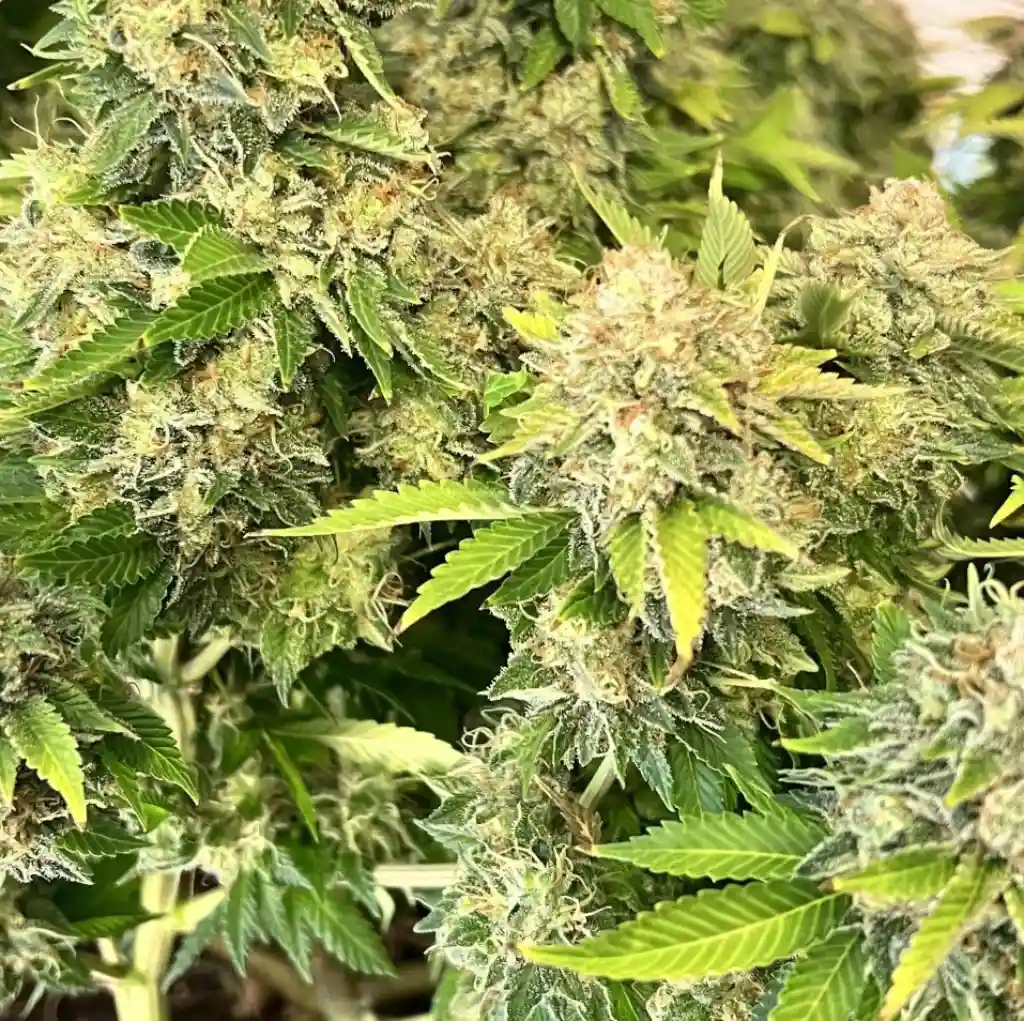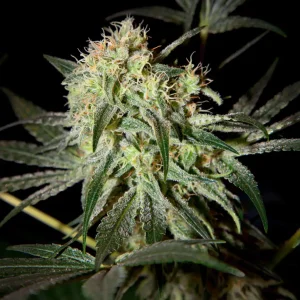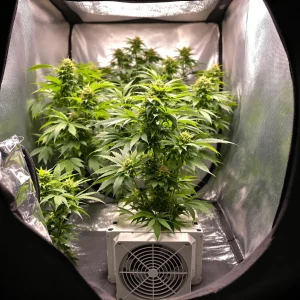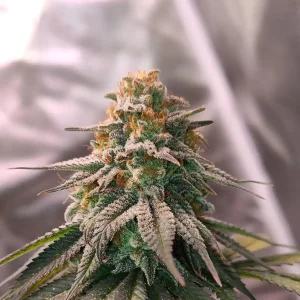Exceptional Genetics and Effects
Sweet Valley Kush is a potent indica-dominant strain celebrated for its robust genetics and intense effects. A cross between Afghan Kush and Hindu Kush, this strain boasts a rich lineage that ensures both quality and consistency. Known for its compact size and dense buds, Sweet Valley Kush is a top choice for growers seeking a high-yielding, resilient plant.
The effects of Sweet Valley Kush are deeply relaxing, making it a favorite for evening use. Its high THC content, often exceeding 22%, delivers a euphoric yet calming experience. Medicinal users frequently turn to this strain for relief from stress, insomnia, and chronic pain, while recreational users enjoy its sedative qualities and sweet, earthy flavor profile.
Environmental Requirements for Growing Sweet Valley Kush Strain
Sweet Valley Kush thrives in environments where conditions are carefully controlled. Ideal temperatures range between 70–80°F during the day, with a slight drop at night. Humidity levels should remain at 50–60% during the vegetative stage and decrease to 40–50% during flowering to prevent mold and mildew.
This strain prefers well-aerated soil or hydroponic setups. Proper lighting is crucial; full-spectrum LED lights work best for indoor grows, while outdoor cultivators should ensure the plants receive ample sunlight. Sweet Valley Kush’s compact size makes it suitable for small grow spaces, but its dense canopy requires regular pruning to improve airflow and light penetration.
Setting Up the Growing Cannabis Space
Creating the ideal growing environment for Sweet Valley Kush involves attention to detail. For indoor setups, use a grow tent or dedicated room with reflective walls to maximize light efficiency. Install adjustable LED lights to accommodate the plant’s growth stages and a ventilation system to maintain fresh air circulation.
Outdoor growers should select a location with plenty of sunlight and protection from harsh weather conditions. Using raised beds or large pots ensures proper drainage and root development. Whether indoors or outdoors, monitoring environmental factors like temperature, humidity, and light cycles is essential for optimal growth.
Indoor Cannabis Cultivation
Growing Sweet Valley Kush indoors provides better control over environmental factors, leading to higher yields and consistent quality. Start with a grow tent equipped with full-spectrum LED lights, a ventilation system, and a reliable timer to maintain an 18/6 light cycle during the vegetative stage.
Use high-quality soil enriched with organic nutrients or opt for a hydroponic system for faster growth. Regularly monitor pH levels, keeping them within 6.0–7.0 for soil or 5.5–6.5 for hydro setups. Prune lower branches to direct energy toward bud development and improve airflow within the canopy.
Outdoor Cannabis Cultivation
Sweet Valley Kush is well-suited for outdoor cultivation, particularly in warm, sunny climates. Choose a planting site with nutrient-rich soil and excellent drainage. To enhance growth, amend the soil with compost or organic fertilizers before planting.
Regularly inspect the plants for signs of pests or diseases, and use natural deterrents like neem oil or companion planting to keep infestations at bay. Outdoor plants can grow larger than indoor ones, so providing stakes or trellises for support is recommended as the buds develop. Harvest typically occurs in late September to early October, depending on local conditions.
Propagation and Germination of Sweet Valley Kush Strain
Germination Techniques
Germinating Sweet Valley Kush Strain seeds requires a precise and gentle approach to ensure healthy seedlings. Start by using the paper towel method, which involves placing the seeds between two moist paper towels and keeping them in a warm, dark environment. Maintain a temperature of 70–80°F (21–26°C) to encourage quick sprouting, typically within 24–48 hours. Check the towels regularly to ensure they remain moist but not overly wet, as excess water can lead to mold.
Alternatively, growers can germinate seeds directly in soil. This method involves planting seeds about ¼-inch deep in a light, well-aerated growing medium. Water the soil gently to keep it moist, and maintain consistent warmth using a heat mat if necessary. This approach is less labor-intensive and reduces the risk of damaging fragile taproots during transplanting.
Caring for Seedlings
Once the seeds have sprouted, transfer them to a small container with nutrient-rich soil. Ensure that the seedlings receive 18 hours of light daily during the initial vegetative stage. Use fluorescent or LED lights to prevent excessive heat and maintain a consistent light cycle. Keep humidity levels between 60–70% to promote healthy development while avoiding conditions conducive to mold. These conditions are especially beneficial for indica strains like Bubba Kush, which thrive in stable, well-controlled environments.
Monitor the seedlings closely for signs of stress, such as discoloration or wilting. Use a light feeding schedule with diluted nutrients to support early growth without overwhelming the fragile plants. Proper care during this stage sets the foundation for robust and productive Sweet Valley Kush plants.
Vegetative Phase of Sweet Valley Kush Strain
Growth Characteristics
During the vegetative phase, Sweet Valley Kush Strain exhibits vigorous growth and develops its characteristic bushy structure. This strain responds well to training techniques such as topping and low-stress training (LST) to maximize light penetration and promote even canopy development. Expect noticeable growth spurts as the plant focuses its energy on developing a strong root system and robust foliage.
The vegetative phase typically lasts 4–6 weeks indoors, depending on the desired plant size. Outdoors, this phase may extend longer, especially in regions with a prolonged growing season. Ensure the plants receive 18–20 hours of light daily to sustain this rapid growth phase.
Environmental Conditions
Maintain temperatures between 70–85°F (21–29°C) during the vegetative stage. Humidity levels should remain around 50–60%, with adequate airflow to prevent stagnant air. Regularly prune excess foliage to enhance air circulation and reduce the risk of pests and diseases.
Provide a balanced nutrient solution with a nitrogen-heavy formula to support lush, green foliage. Monitor the plants for signs of nutrient deficiencies or excesses, and adjust feeding schedules accordingly. Consistent care during the vegetative phase lays the groundwork for a successful flowering stage and higher yields.
Flowering Phase of Sweet Valley Kush Strain
Transitioning to Flowering
Sweet Valley Kush typically enters the flowering phase when light cycles are adjusted to 12 hours of light and 12 hours of darkness. For outdoor growers, this transition occurs naturally as the days shorten in late summer. The flowering period for Sweet Valley Kush lasts approximately 8–9 weeks, during which the plants develop dense, resin-coated buds with a rich aroma.
During this phase, closely monitor environmental conditions. Lower humidity levels to 40–50% to prevent mold and mildew on the developing buds. Temperatures should remain between 65–80°F (18–26°C) to ensure optimal growth and terpene production.
Enhancing Bud Quality
To maximize bud quality, provide phosphorus and potassium-rich nutrients during the flowering stage. Avoid overfeeding, as excess nutrients can lead to nutrient burn and negatively impact flavor and potency. Supplemental lighting, such as high-intensity discharge (HID) or full-spectrum LED lights, ensures the plants receive sufficient energy for robust bud development.
Regularly inspect the plants for pests or signs of stress, as issues can quickly escalate during the flowering phase. Proper airflow and pruning of lower branches help direct the plant’s energy to the top buds, enhancing both yield and quality. By the end of the flowering stage, Sweet Valley Kush plants produce dense, trichome-rich buds with a distinctive aroma and flavor profile.
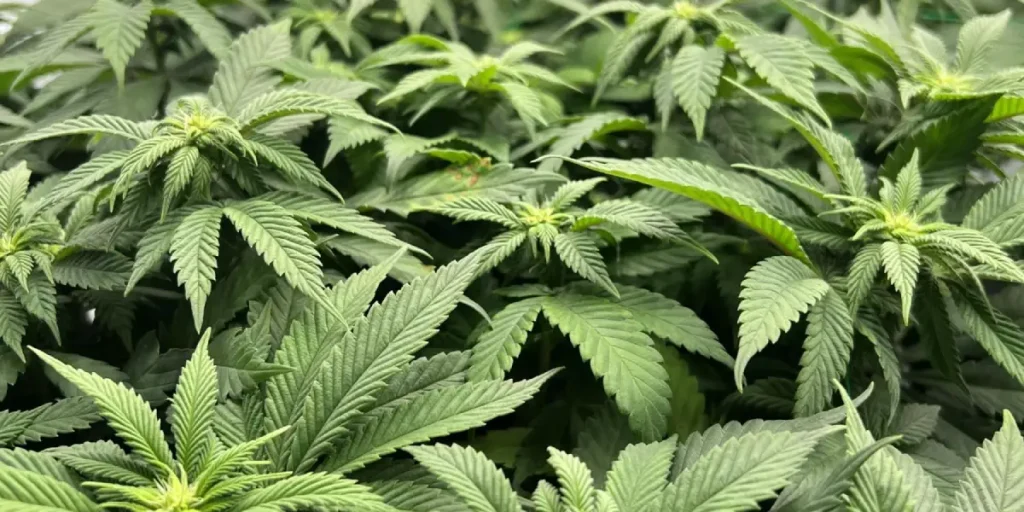
Cannabis Fertilization and Nutrition – Sweet Valley Kush Strain
Nutrient Requirements
Sweet Valley Kush requires a tailored nutrient regimen to support its growth stages. During the vegetative phase, prioritize nitrogen-rich fertilizers to encourage leafy growth. As the plants transition to flowering, shift to a phosphorus and potassium-heavy formula to promote bud development and resin production.
Incorporating micronutrients like calcium, magnesium, and iron ensures balanced nutrition and prevents deficiencies that can stunt growth or reduce yield. Use pH-adjusted water (6.0–7.0 for soil and 5.5–6.5 for hydroponics) to optimize nutrient absorption and minimize the risk of lockout.
Organic vs. Synthetic Nutrients
Growers can choose between organic and synthetic nutrients based on their cultivation preferences. Organic options, such as compost teas and worm castings, enhance soil health and contribute to a rich terpene profile. Synthetic nutrients, on the other hand, offer precise control over feeding schedules and nutrient concentrations, making them suitable for high yield indoor setups.
Regardless of the choice, monitor plants for signs of nutrient imbalances, such as yellowing leaves or slow growth. Adjust feeding schedules and concentrations as needed to maintain healthy, productive plants throughout the growth cycle.
Pest and Disease Control for Cannabis Growing
Common Pests and Prevention
Sweet Valley Kush is susceptible to common cannabis pests, including spider mites, aphids, and whiteflies. Prevent infestations by maintaining a clean growing environment and using sticky traps to monitor pest activity. Introduce beneficial insects, such as ladybugs and predatory mites, to keep pest populations in check naturally.
Regularly inspect the plants for early signs of infestation, such as discolored leaves or visible insects. Prune affected areas and dispose of them safely to prevent the pests from spreading. Consistent monitoring and proactive measures significantly reduce the likelihood of pest-related issues.
Disease Management
Mold and mildew are the most common diseases affecting cannabis plants, especially in high-humidity environments. Prevent these issues by maintaining proper humidity levels and ensuring adequate airflow through pruning and oscillating fans. Use organic fungicides or neem oil as preventive treatments to protect the plants.
In case of infection, isolate the affected plants immediately to prevent the disease from spreading. Remove infected areas and adjust environmental conditions to inhibit further growth of mold or mildew. With timely intervention, growers can minimize the impact of diseases on their Sweet Valley Kush crops.
Growing Prevention Corrective Actions
Preventing Issues in Sweet Valley Kush Strain Cultivation
Preventing problems in your Sweet Valley Kush grow begins with maintaining a stable and optimal environment. Ensure that temperatures are consistently between 68–78°F during the day and slightly cooler at night. Humidity levels should be kept between 40–60% during the vegetative stage and lowered to 30–50% during flowering. Good airflow is critical, as it prevents mold and mildew from taking hold. Use oscillating fans and strategically placed exhaust systems to maintain air circulation.
Proper watering practices are essential. Overwatering or underwatering can stress plants and lead to deficiencies. Monitor the soil’s moisture level and stick to a consistent watering schedule. Incorporating preventative pest control, such as introducing beneficial insects like ladybugs, can protect your crop from harmful pests like spider mites or aphids.
Corrective Actions for Common Problems
Despite preventive measures, growers may still encounter issues. Yellowing leaves might indicate nitrogen deficiency, which can be corrected by adding a nitrogen-rich fertilizer. Leaf curling or spotting often points to pH imbalances—ensure the soil pH is between 6.0–7.0 for optimal nutrient uptake.
If pests are present, act quickly by spraying affected areas with neem oil or introducing predator insects. For fungal issues like powdery mildew, prune infected areas immediately and adjust humidity levels. Regularly check plants for signs of stress or disease to catch problems early and prevent further damage.
Harvesting and Curing Sweet Valley Kush Strain
Harvesting Techniques
Sweet Valley Kush typically reaches maturity after 8–9 weeks of flowering. When preparing for harvest, look for signs such as trichomes turning milky white with some amber hues, and about 70–90% of pistils changing to orange. Using a magnifying glass or jeweler’s loupe can help you confirm the readiness of the buds.
Carefully cut the branches using clean, sharp scissors and hang them upside down in a dark room. The drying space should have a temperature of 65–75°F and humidity levels around 50%. Ensure there is adequate ventilation to prevent mold and rotate the hanging branches occasionally to ensure even drying.
Curing for Premium Quality
Once dried, transfer the buds to airtight glass jars. Open the jars daily during the first two weeks to release excess moisture—a process known as “burping.” This step is essential to preserve the terpene profile and prevent mold. Over the following weeks, continue to monitor the moisture content, ensuring the buds are dry to the touch but not crumbly.
Curing Sweet Valley Kush for at least four weeks enhances its earthy, sweet flavor and ensures a smoother smoking experience. Store jars in a cool, dark place for long-term freshness and consider using humidity packs to maintain optimal moisture levels.
Is Sweet Valley Kush Strain Indica or Sativa?
Genetic Breakdown
Sweet Valley Kush is a pure indica strain, derived from the cross of Afghan Kush and Hindu Kush. Its strong indica lineage makes it an ideal choice for those seeking relaxation and pain relief. The strain’s genetics contribute to its short stature, bushy growth pattern, and dense, resin-covered buds.
Effects and Characteristics
As an indica-dominant strain, Sweet Valley Kush is renowned for its deeply relaxing effects. It delivers a calming body high that soothes aches and promotes restful sleep, making it a popular choice for evening use. The strain also offers a mild cerebral euphoria, enhancing mood without overwhelming the senses.
Medical users often choose Sweet Valley Kush for its ability to alleviate chronic pain, stress, and insomnia. Its potent effects make it a go-to strain for relaxation and recovery.
Advantages of Growing Sweet Valley Kush Strain
High Resin Production
Sweet Valley Kush is a favorite among growers due to its exceptional resin production. This characteristic makes it ideal for creating concentrates like hash or rosin. The thick layer of trichomes not only enhances potency but also gives the buds a striking, frosty appearance.
Compact Growth and High Yield
This strain’s compact growth makes it perfect for indoor cultivation or small outdoor spaces. Despite its short stature, Sweet Valley Kush delivers impressive yields, producing up to 18 ounces per square meter indoors and even more in outdoor setups under optimal conditions.
Disadvantages of Growing Sweet Valley Kush Strain
Sensitivity to Humidity
Sweet Valley Kush’s dense buds are prone to mold if humidity levels are not carefully controlled. Growers must ensure proper airflow and maintain low humidity during the flowering stage to prevent potential issues.
Long Vegetative Phase
While the flowering phase is relatively short, the vegetative phase of Sweet Valley Kush can take longer than other strains. This extended growth period requires patience and consistent care, which may not suit growers looking for a faster turnaround.
Problems in Cultivating Sweet Valley Kush Strain
Pest Susceptibility
Although generally resilient, Sweet Valley Kush can attract pests like spider mites and aphids. Regular monitoring and preventive measures such as neem oil sprays or introducing predatory insects can help keep infestations under control.
Nutrient Sensitivity
This strain can be sensitive to overfeeding, particularly during the flowering stage. Signs of nutrient burn, such as browning leaf tips, indicate the need to reduce nutrient levels and flush the soil if necessary. Using a balanced feeding schedule tailored to the plant’s needs can prevent these issues.
Advanced Pest Control for Cannabis Growing
Biological Controls
Advanced growers can incorporate biological pest control methods, such as introducing beneficial nematodes or predatory mites, to target specific pests. These natural solutions are highly effective and minimize the use of chemical pesticides.
Preventive Techniques
Using companion planting with herbs like basil or marigold can deter pests naturally. Additionally, setting up sticky traps and maintaining a clean grow space reduces the likelihood of infestations. Regularly inspecting plants for early signs of pests ensures swift action and protects the overall health of the crop.
Similar Strains to Sweet Valley Kush Strain
Sweet Valley Kush Strain’s distinct characteristics make it unique, but there are other strains that offer comparable flavors, effects, or growing traits. Here are some excellent alternatives for those who enjoy Sweet Valley Kush.
Bubba Kush
Bubba Kush is a classic indica strain known for its calming effects and earthy flavor profile. Much like Sweet Valley Kush, Bubba Kush delivers a deep sense of relaxation that’s perfect for unwinding after a long day. Its compact plant structure makes it ideal for indoor cultivation, and its dense buds are rich with resin, appealing to growers seeking high yields for extracts.
Growers will appreciate Bubba Kush’s resilience against pests and mold. Its flowering period is relatively short, similar to Sweet Valley Kush, typically finishing in 8–9 weeks. This strain’s earthy and sweet notes, coupled with its tranquilizing effects, make it a comparable and versatile choice.
OG Kush
A legendary hybrid, OG Kush shares Sweet Valley Kush’s kush lineage, offering a balanced mix of cerebral stimulation and physical relaxation. OG Kush is prized for its piney and citrusy aroma, combined with hints of earthy spice. It’s a great option for those who appreciate Sweet Valley Kush but desire a slightly more uplifting effect.
OG Kush thrives in controlled indoor environments but can also perform well outdoors in warmer climates. It’s a moderately challenging strain to grow, requiring precise nutrient management and humidity control. Despite these challenges, the rewarding yields and complex terpene profile make it a favorite among cultivators and consumers alike.
Hindu Kush
Hindu Kush, another classic indica, shares many similarities with Sweet Valley Kush, including its deeply relaxing effects and earthy, sweet flavor profile. This strain’s roots trace back to the mountain ranges between Pakistan and Afghanistan, giving it a rich history and robust genetics.
Hindu Kush is particularly suited for growers seeking a resilient plant with a short flowering time of 7–8 weeks. Its compact size and high resin production make it a favorite for producing concentrates. The calming effects and soothing flavors make it a perfect strain for stress relief and relaxation.
Week-by-Week Growth Plan for Sweet Valley Kush Strain
Growing Sweet Valley Kush Strain successfully requires following a structured plan to meet its unique needs at each stage. Here’s a week-by-week guide to help you achieve optimal results.
Week 1–2: Germination and Seedling Stage
- Environment: Keep temperatures between 70–80°F and humidity levels at 70–80%.
- Lighting: Use 18–20 hours of light daily from CFLs or LED grow lights.
- Care Tips: Water sparingly to avoid overwatering and use a seedling-specific nutrient mix to promote healthy root development.
During this stage, Sweet Valley Kush Strain seeds sprout and develop their first true leaves. Ensure the seedlings are supported with gentle airflow to strengthen their stems.
Week 3–4: Early Vegetative Stage
- Environment: Maintain temperatures at 70–75°F and humidity at 50–60%.
- Lighting: Continue 18–20 hours of light with higher-intensity LED or MH lights.
- Care Tips: Begin low-stress training (LST) to encourage lateral growth and increase light exposure to lower nodes.
The plants grow rapidly during this stage, developing strong stems and lush foliage. Regularly check the pH of your soil or hydroponic system to ensure nutrient uptake.
Week 5–6: Late Vegetative Stage
- Environment: Maintain stable temperatures and reduce humidity to 45–55%.
- Lighting: Keep the light schedule consistent at 18–20 hours daily.
- Care Tips: Prune lower branches and leaves to improve airflow and focus energy on upper growth. Transition to a nutrient mix with higher nitrogen content.
Sweet Valley Kush Strain plants will display vigorous growth, and it’s essential to support them with proper staking or trellising to prepare for the flowering phase.
Week 7–9: Early Flowering Stage
- Environment: Lower humidity further to 40–50% while keeping temperatures stable at 70–75°F.
- Lighting: Switch to a 12/12 light schedule to trigger flowering.
- Care Tips: Introduce a bloom-specific nutrient mix rich in phosphorus and potassium. Monitor for signs of nutrient deficiencies or pest issues.
Buds begin to form during this stage, and the plant’s aroma becomes more pronounced. Maintain optimal airflow and monitor trichome development closely.
Week 10–11: Late Flowering Stage
- Environment: Keep humidity levels low at 35–45% to prevent mold and mildew.
- Lighting: Maintain the 12/12 light cycle.
- Care Tips: Gradually reduce nutrients and flush the plants with plain water during the final week to improve flavor and smoothness.
The buds will reach their full size and potency, with trichomes turning milky white or amber, signaling peak maturity. Regularly inspect the plants to ensure they remain healthy and free from pests.
Week 12: Harvest
- Environment: Drying space temperatures should be 65–75°F with 50% humidity.
- Care Tips: Harvest the buds when 70–90% of the pistils are orange and trichomes have the desired color. Use sharp scissors to trim the buds and hang them upside down to dry.
Curing the dried buds for at least four weeks enhances the flavor and potency of Sweet Valley Kush, ensuring a premium final product.
FAQs About Sweet Valley Kush Strain
What is the flavor profile of Sweet Valley Kush Strain?
Sweet Valley Kush Strain offers a rich and sweet flavor with hints of berry and earthy undertones. The complex terpene profile makes it a favorite for those seeking a flavorful smoking experience.
Is Sweet Valley Kush Strain easy to grow?
Yes, Sweet Valley Kush is beginner-friendly due to its resilient genetics and adaptability to various growing conditions. It’s resistant to common pests and diseases, making it suitable for novice cultivators.
What are the effects of Sweet Valley Kush Strain?
Sweet Valley Kush delivers deeply relaxing effects, making it ideal for stress relief, pain management, and improving sleep quality. Its calming properties make it a popular choice for evening use.
How long does it take to grow Sweet Valley Kush Strain?
The complete growth cycle for Sweet Valley Kush is approximately 12 weeks, with a flowering period of 7-8 weeks. Proper care and environmental conditions can maximize yields and quality.

